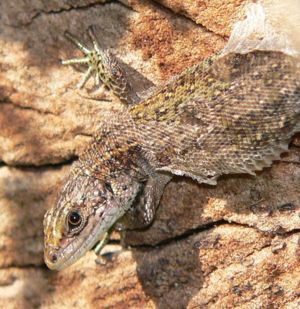Difference between revisions of "Lizard Shedding"
| (3 intermediate revisions by 2 users not shown) | |||
| Line 1: | Line 1: | ||
{{review}} | {{review}} | ||
[[Image:Lizard_shedding.jpg|300px|thumb|right|'''Viviparous lizard (''Zootoca vivipara'') shedding its skin''' (© Piet Spaans, WikiMedia Commons)]] | [[Image:Lizard_shedding.jpg|300px|thumb|right|'''Viviparous lizard (''Zootoca vivipara'') shedding its skin''' (© Piet Spaans, WikiMedia Commons)]] | ||
| − | + | ||
| − | |||
Shedding is the normal process of skin renewal. The frequency depends upon the rapidity of growth, age, nutritional state, size and environmental factors. For most lizards, the skin sheds in patches, except for the alligator lizard which sheds in one piece. | Shedding is the normal process of skin renewal. The frequency depends upon the rapidity of growth, age, nutritional state, size and environmental factors. For most lizards, the skin sheds in patches, except for the alligator lizard which sheds in one piece. | ||
| Line 17: | Line 16: | ||
To fasten the shed, it might be useful to bathe or spray the iguana with water. Indeed, in the wild, humidity in the air helps keep the old skin supple and therefore easier to peel off. | To fasten the shed, it might be useful to bathe or spray the iguana with water. Indeed, in the wild, humidity in the air helps keep the old skin supple and therefore easier to peel off. | ||
| − | A healthy iguana will shed every 4-6 weeks during 1-2 weeks but young iguanas (2 to 3 years) may shed more often. Occasionally, a new shed may start before the previous one has ended. Shedding will slow down or stop during colder weather. Absence of shedding which cannot be linked to seasonality may be an indicator of an underlying problem, possibly associated with an inadequate [[ | + | A healthy iguana will shed every 4-6 weeks during 1-2 weeks but young iguanas (2 to 3 years) may shed more often. Occasionally, a new shed may start before the previous one has ended. Shedding will slow down or stop during colder weather. Absence of shedding which cannot be linked to seasonality may be an indicator of an underlying problem, possibly associated with an inadequate [[Lizard Diet|diet]], disease, stress, bacterial infections, [[Lizard Mites|parasite infestations]], or other medical conditions. |
If the dead skin isn't shed, it may constrict the growth of the living tissue and result in [[Lizard Avascular Necrosis of Digits or Tail|avascular necrosis]]. | If the dead skin isn't shed, it may constrict the growth of the living tissue and result in [[Lizard Avascular Necrosis of Digits or Tail|avascular necrosis]]. | ||
Revision as of 16:30, 2 April 2010
| This article has been peer reviewed but is awaiting expert review. If you would like to help with this, please see more information about expert reviewing. |
Shedding is the normal process of skin renewal. The frequency depends upon the rapidity of growth, age, nutritional state, size and environmental factors. For most lizards, the skin sheds in patches, except for the alligator lizard which sheds in one piece.
A change in colour can be noted prior to shedding; the overall shade of the lizard gets progressively dimmer and duller around the head and limbs and grey/ white patches of skin begin to appear, progressing from head to tail. The shedding occurs on all parts of the body, including eyelids.
Behaviour
Lizards tend to rub themselves on surfaces to loosen the dead skin. Their behaviour may become more aggressive, especially while being held or touched.
While reptiles may still eat when in the very early phase of the pre-shed period, they usually lose their appetite as the period progresses, greatly reducing their food intake or refraining from eating alltogether.
Possible Complications
To fasten the shed, it might be useful to bathe or spray the iguana with water. Indeed, in the wild, humidity in the air helps keep the old skin supple and therefore easier to peel off.
A healthy iguana will shed every 4-6 weeks during 1-2 weeks but young iguanas (2 to 3 years) may shed more often. Occasionally, a new shed may start before the previous one has ended. Shedding will slow down or stop during colder weather. Absence of shedding which cannot be linked to seasonality may be an indicator of an underlying problem, possibly associated with an inadequate diet, disease, stress, bacterial infections, parasite infestations, or other medical conditions.
If the dead skin isn't shed, it may constrict the growth of the living tissue and result in avascular necrosis.
